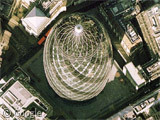Brief post that may be of interest to those who found my
previous post on Internet Atronomy interesting.
It might make a good schhol activity as well:
"Observe with NASA in the annual Astrophotography
Contest!
The Harvard-Smithsonian Center for Astrophysics, NASA, and
Astronomers Without Borders invite you to share your views of the universe in
this exciting astrophotography contest. The images that YOU take using online
robotic telescopes could be featured on the Observing With NASA home page!
Who can participate? Anyone with an email address
can use the MicroObservatory robotic telescopes to request electronic images of
astronomical objects. If you are 13 or younger, you will need a parent or
guardian to enter your photos for you.
What are we looking for? Since you are Observing
With NASA, we invite you to take your own images with the OWN portal, and then
submit them along with a NASA image of the same celestial object. For example,
if you take and process an image of the Lagoon Nebula using MicroObservatory,
include an image of the Lagoon Nebula taken by a NASA telescope. Write a short
comparison of the two images. It is okay if your image is very different from
the NASA image! The idea is to look at the same object in two different ways,
whether it be through different wavelengths of light, or through different
creative lenses. We will have one winner for the best technical image,
and one winner for the best astrocreative image. For examples, please see
the MicroObservatory Facebook page.
Are there resources to help me? Yes! Check out our
Tools & Training
webpage. There are short video tutorials that cover many topics, including how
to make an Advanced RGB image! For finding NASA images, we recommend looking at
the Hubble, Chandra, WISE, and Spitzer websites.
How do I share my images? Save your
MicroObservatory image as a .GIF and NASA image as a .JPG and send them as an
attachment to MicroObservatory@cfa.harvard.edu.
Tell us anything you would like about your image and include this template in
your email:
- First Name and Last Initial:
- Age (underline one): Under 13 13-18 18-24 25 and up
- Title of your image:
- Name of astronomical object:
- How you made your image:
- Which telescope took the NASA image:
- Comparison of the two images (What kind of light does the NASA telescope
detect? What features are different?):
- Anything you would like us to know:
When does the contest end? Enter your images by
Monday, April 30th. We will announce the winners mid-May.
What do I get if I win? The two winners will be
featured on the Observing With NASA website, along with their images. In
addition, the winners will receive a certificate from the Harvard-Smithsonian
Center for Astrophysics and NASA along with a package of Astronomy prizes.
Click here
for more details.
Detailed Instructions for the MicroObservatory
Astrophotography Contest
STEP 1: Control a Telescope
MicroObservatory is an online network of robotic
telescopes that you can control over the Internet from your own computer.
2. Choose your target(s) and click "OBSERVE" to take an
image of that object.
3. Choose your field of view, exposure time, and filters;
then click "CONTINUE".
4. Enter your (confidential) information and "SUBMIT" your
request to the telescopes.
5. Look for an email the next day containing a link to
download your requested image(s).
STEP 2: Create Your Images
MicroObservatoryImage is a free easy-to-use software
program that helps you turn your telescope images into cool
astrophotographs.
1. Download the image processing software to your
computer.
2. Install the software on your machine by extracting the
downloaded file and start the program by double clicking on the application icon
("MicroObservatoryImage.app" for Macintosh, "run.bat" for PCs).
3. Download your image(s) by clicking on the link in your
email and downloading the FITS file to your computer.
4. Open your image(s) by dragging it into the open
software program or opening it using the File menu at the top of the program
screen.
5. Use the processing tools in the menus and toolbars to
bring out detail and colorize your image(s).
6. Save each image as a GIF file (don't forget to add the
.GIF extension!)
NEED MORE INFO? Download the Illustrated Processing Tools
Guide (1.5 Mb PDF) from the Tools & Training
page to see step-by-step instructions for opening and using the image
processing software.
STEP 3: Share Your Images
2. Include this template:
- First Name and Last Initial:
- Age (underline one): Under 13 13-18 18-24 25 and up
- Title of your image:
- Name of astronomical object:
- How you made your image:
- Which telescope took the NASA image:
- Comparison of the two images (What kind of light does the NASA telescope
detect? What features are different?):
- Anything you would like us to know:
STEP 4: Check Observing With NASA for the
winners!
1. Wait to hear from us to see if you've won!
Check back to Observing With NASA at the end of April to
see the winning entries!
* Note: Only images taken with the MicroObservatory
telescopes and processed with MicroObservatoryImage software will be eligible to
win."
 The Maths department experts were somewhat reminiscent of the panel in Countdown without the adjudication role (which was Marcus du Sautoys role along with problem-setting).
The Maths department experts were somewhat reminiscent of the panel in Countdown without the adjudication role (which was Marcus du Sautoys role along with problem-setting).




